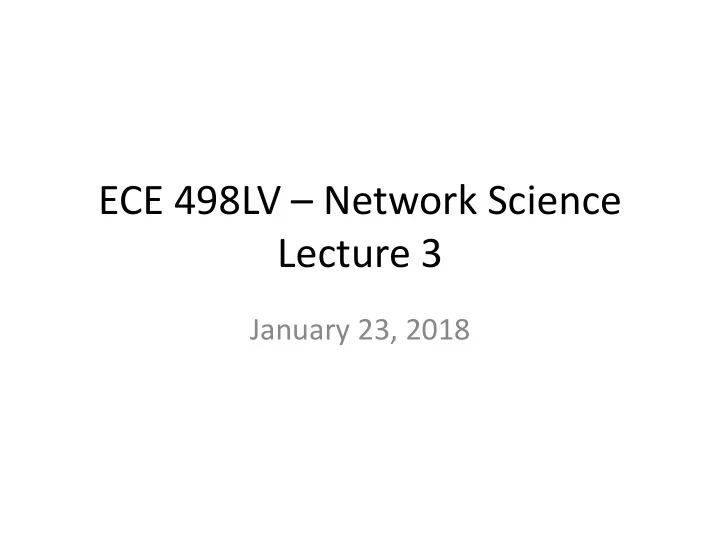

ECE 498LV – Network Science Lecture 3 January 23, 2018
How does the brain work?
Analogies to Technology • Mechanical devices like • Electrical devices like phonographs, telegraph pianos, steam engine repeaters, diodes, triodes, governors, water systems, city, enchanted loom multi-vibrators, amplifiers • Telephone exchange • Computer [Kyle L. Kirkland, “High -Tech Brains: A History of Technology-Based Analogies and Models of Nerve and Brain Function,” Perspectives in Biology and Medicine , Spring 2002.]
Neuron Doctrine • The neuron doctrine is the concept that the nervous system is made up of discrete individual cells • Nerve cells are connected by sites of contact and not cytoplasmic continuity
Allometric Scaling • Allometry studies the relationship between body size to shape. Goes back to D'Arcy Thompson’s On Growth and Form (1917) • In neurobiology, one can look at allometric scaling relationships: – across different species with similar brain architectures [evolution], – scaling relationships for different individuals of same species [growth], – properties of the brain within the same individual [structure] • The relationship between the two measured quantities is usually expressed as a power law equation: 𝑧 = 𝑙𝑦 𝛽 where 𝛽 is the scaling exponent of the law. • How should we interpret superlinear ( 𝛽 > 1 ) or sublinear ( 𝛽 < 1 ) scaling?
Allometric Scaling Encephalization quotient E = CS 2 , where E and S are body and brain weights [https://en.wikipedia.org/wiki/Brain-to-body_mass_ratio]
Allometric Scaling [Heinz Stephan, Heiko Frahm, and Georg Baron, "New and Revised Data on Volumes of Brain Structures in Insectovores and Primates," Folia Primatol., vol. 35, pp. 1-29, 1981.]
Allometric Scaling Scaling of the total basal cerebral metabolism with brain volume . The least-square fit line for the log – log plot yields the following. ( A ) For the total oxygen consumption rate, the scaling exponent was 0.86 ± 0.04 (y = 0.86x - 1.02, R 2 = 0.989, p < 10 -4 , n = 7), and its 95% confidence interval was 0.75 to 0.96. ( B ) For the total glucose utilization rate, an identical exponent 0.86 ± 0.03 was found (y = 0.86x - 0.09, R 2 = 0.994, p < 10 -4 , n = 10) and its 95% confidence interval was 0.80 to 0.91. [Jan Karbowski , “Global and regional brain metabolic scaling and its functional consequences,” BMC Biology , 2007, 5:18.]
Are there common allometric scalings among different kinds of networks?
Are there common allometric scalings among different kinds of networks?
(Human) Connectomics
• A key challenge is that basic structural elements of the human brain, in terms of network nodes and connections, are difficult to define. – Parcellation • Different kinds of structural descriptions could target at least three rather distinct levels of organization. – Microscale - the level of single neurons and synapses – Mesoscale - the level of neuronal groups or populations – Macroscale - the level of anatomically distinct brain regions and inter-regional pathways • It is important to determine which level of description is the most appropriate for a given connectome application
Microscale • With single neurons as the basic element, the size of the connectome is several orders of magnitude larger than of the genome, comprising roughly 10 11 neurons and 10 15 connections between them • Alterations of single synapses have not been shown to have macroscopic effects; human cognitive functions depend on the activity and coactivity of large populations of neurons in distributed networks • Individual neurons and connections are subject to rapid plastic changes, including synaptic weights as well as structural remodeling of dendritic spines and presynaptic boutons
Macroscale • Brain areas and neuronal populations are difficult to delineate: No single universally accepted parcellation scheme currently exists for human brain regions • Feasible to actually determine human connectome at this organizational level, but insufficient for a complete understanding of the human brain’s functional dynamics and information processing capabilities Diffusion Tensor Imaging (DTI) is an MRI-based neuroimaging technique which makes it possible to estimate the location, orientation, and anisotropy of the brain's white matter tracts.
Anatomical and Functional Connectivity Annals of the New York Academy of Sciences Volume 1224, Issue 1, pages 109-125, 4 JAN 2011 DOI: 10.1111/j.1749-6632.2010.05888.x http://onlinelibrary.wiley.com/doi/10.1111/j.1749-6632.2010.05888.x/full#f1
• Pregnancy causes substantial changes in brain structure, primarily reductions in gray matter (GM) volume in regions subserving social cognition. • Changes were selective for the mothers and highly consistent, correctly classifying all women as having undergone pregnancy or not in-between sessions • Speculate that the female brain undergoes a maturation or specialization of the neural network subserving social cognition during pregnancy
Figure 5. Subnetwork distributions for the gap junction network. Varshney LR, Chen BL, Paniagua E, Hall DH, Chklovskii DB (2011) Structural Properties of the Caenorhabditis elegans Neuronal Network. PLOS Computational Biology 7(2): e1001066. doi:10.1371/journal.pcbi.1001066 http://journals.plos.org/ploscompbiol/article?id=10.1371/journal.pcbi.1001066
[Ron Milo, Shalev Itzkovitz, Nadav Kashtan, Reuven Levitt, Shai Shen-Orr, Inbal Ayzenshtat, Michal Sheffer, Uri Alon, “ Superfamilies of Evolved and Designed Networks,” Science, 2004.]
Recommend
More recommend